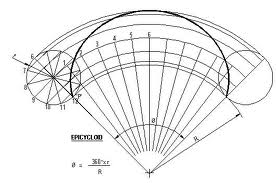Epicycloid:
If a circle of diameter D rolls on the outside of another circle of radius R, the path of the point A is like on the rolling circle is called an epicycloids as display in diagram.
To sketch the epicycloids, describe a rolling circle of diameter D and a guiding circle of radius R tangent to it at point 12. Divide the rolling circle into 12 equal parts. With Oo like a center and a radius equal to R + D/2 sketch an auxiliary arc. From the point A and clockwise layout on the guiding circle mark 12 divisions, each one equal to 1/12 π D. To find out the arc of the guiding circle AA12 = π D, use the formula α =180o D/R.

The angle α hence obtained is divided into 12 equal parts along with the aid of a protractor and the points are denoted as 1′ via 12′. From Oo and via these points draw radial lines whose extensions will intersect the auxiliary arc at point O1 via O12. Along with Oo like a center describe a series of auxiliary arcs passing via the points of division of the rolling circle.
From O1 via O12 as centers and along with a radius equal to D/2 describe arcs to intersect the corresponding auxiliary arcs at points A1 via A12. A smooth curve is then drawn via these points to get the required epicycloids.